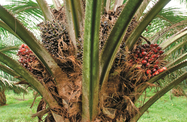After a slow year in 2012, Malaysian officials expect exports of crude palm oil (CPO) to expand in 2013. Prices that have fallen due to oversupply and slower demand are now on the rise again, and though they may moderate in the second half of the year, an average steady climb over the next two years seems likely.
CPO is a major export earner for the country, which is the world’s second-largest producer of the product. In 2012 Malaysia exported RM71.5bn ($23.03bn) worth of palm oil, down from RM80.4bn ($25.9bn) in 2011 – an all-time high. The 11% drop was largely attributed to a fall in CPO prices caused by a number of factors, including the uncertain international economic environment, a production glut and controls on the CPO trade. The average CPO price fell 27% year-on-year (y-o-y) and 24% quarter-on-quarter in the last quarter of 2012.
Despite this, officials believe the long-term outlook for CPO exports looks sound. In February Hamzah Zainuddin, deputy minister of plantation industries and commodities, said he expected CPO exports to exceed the 2011 record within three to five years. Even given ongoing issues of inventory surplus, the ministry forecasts growth in 2013, partly thanks to an export tax cut.
From January, the government brought the levy down from 23% to a sliding scale between 4.5% and 8.5%; if the CPO price falls below RM2250 ($725), the tax will be cancelled. Meanwhile, Indonesia, the world’s largest CPO exporter, raised its export tax from 7.5% to 9% in January.
Mohammad Jaaffar Ahmad, CEO of the Palm Oil Refiners Association of Malaysia (PORAM), said his members were already “seeing better margins as they ramp up production”. Jaaffar said rising exports would help lower Malaysia’s inventory, which was in substantial surplus at 2.53m tonnes at the end of January 2013, to a “manageable level” of 2m tonnes.
In the first half of February, Malaysian palm oil shipments rose 18%, to 673,555 tonnes, following a 10% decline in output and 1.6% fall in exports in January, the former partly attributable to a run-down of existing stocks and seasonal factors. Rabobank, a Dutch agricultural bank, said it expected Malaysia’s palm oil production to fall 2% y-o-y in the first six months of 2013 as the inventory is fed into exports. However, Malaysia-based Kenanga Research said that it did not expect stocks to fall below 2m tonnes in the first quarter of 2013 due to lower export demand.
Jaafaar said he expected the price of CPO to rise as inventories ran down. In early February, it climbed to around the RM2250 ($725) tax threshold, and by the end of the month, it stood at RM2330 ($751). Meanwhile, futures for delivery in April topped RM2500 ($805) in mid-February. Officials take the view that prices have now bottomed out, as the surplus falls and a number of demand factors kick in, but also due to a seasonal drop in production.
Local press reported that analysts expect prices to rise to RM2600-2700 ($838-870) by the middle of 2013. Kuala Lumpur-based RHB Research Institute, part of bank RHB, has said it has a price assumption of RM2800 ($902) per tonne for 2013, rising to RM3000 ($966) in 2014. It expects prices to fall again in the second half of this year due to the seasonal rise in output.
Meanwhile, Kenanga expects an average price of RM2500-2700 ($805-870) this year and next, and takes a more bearish view on planters’ stocks than some of its counterparts. PublicInvest Research has a neutral recommendation, expecting an average price of RM2750 ($886) this year and RM2850 ($918) in 2013.
As ever, CPO prices will be strongly influenced by the global economic situation, particularly by major importers, such as China and India. India’s proposal to levy a tax on CPO imports concerns Malaysian planters, for whom the country is the second-largest market. With the worldwide economy expected to grow only moderately in 2013 and 2014, it is little surprise that CPO prices are unlikely to reach the peaks seen five years ago. However, as oversupply moderates, a steady rise should boost the sector.

